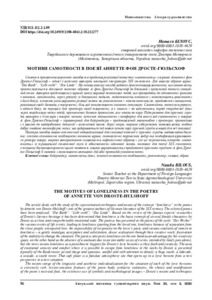Please use this identifier to cite or link to this item:
http://elar.tsatu.edu.ua/handle/123456789/12787Full metadata record
| DC Field | Value | Language |
|---|---|---|
| dc.contributor.author | Білоус, Наталя Володимирівна | - |
| dc.contributor.author | Белоус, Наталья Владимировна | - |
| dc.contributor.author | Bilous, Natalia | - |
| dc.date.accessioned | 2021-01-06T09:16:56Z | - |
| dc.date.available | 2021-01-06T09:16:56Z | - |
| dc.date.issued | 2020 | - |
| dc.identifier.uri | http://elar.tsatu.edu.ua/handle/123456789/12787 | - |
| dc.description.abstract | UK: Стаття присвячена вивченню засобів та прийомів реалізації концепту «самотність» у віршах Аннетте фон Дросте-Гюльсхоф – однієї з величних авторок німецької літератури ХІХ століття. Для аналізу обрано вірші: “Die Bank”, “Lebt wohl”, “Die Linde”. На основі аналізу студій відомих дростезнавців визначено, що самотність простежується в декількох жіночих образах А. фон Дросте-Гюльсхоф як близький і зрозумілий поетесі емоційний стан. Авторка представила у віршах циклу варіації життєвих подій, що призводять до одинокості (розлука з коханим, самотність через розлуку із близькими людьми, недосяжність коханого і неможливість взаємності з його боку), а також різні варіанти реакції жінки на усамітнення – ніжна ностальгія; прийняття і заміщення, реалізація своїх бажань у творчості; біль від неможливості змінити ситуацію. Самотність поетеса трактує, з одного боку, як перевагу для простору своєї творчості, а з іншого – як відсутність поряд спорідненої душі через невідхильну низку подій, призначених божим промислом, але ніколи як кару. Підтримкою для ліричних героїнь авторки є їхня віра і творче начало, куточок захищеності і комфорту для втечі від самотності у творах А. фон Дросте-Гюльсхоф – характерний для бідермейєра – представлений масштабно і просторо, проникливо і з увагою до найдрібніших деталей – величезний замок, берег озера, морське узбережжя, замкова вежа, тобто добре знайоме атмосферне місце, що відкривається під новим кутом зору ліричній героїні в новій для неї ситуації. Палітра засобів мовно-естетичної індивідуалізації для ситуації кожної з ліричних героїнь надзвичайно багата: лексико-семантичні особливості тканини вірша, синтаксичні порушення, вибір та модифікація віршованого розміру твору, широке використання символів та міфологічних образів – усе це переносить концепт «самотність» із тривіальної статичної туги й обмеженості одинокої жінки, типових для поезії ХІХ століття, у площину багатовимірності цього поняття, ініціює варіативність сприйняття ліричною героїнею А. фон Дрос-те-Гюльсхоф її самоти і можливості активних дій або протидій усамітненості. EN: The article deals with the study of the representation techniques and means of the concept “loneliness” in the poems by Annette von Droste-Hulshoff – one of the greatest authors of German literature of the XIX century. The selected poems have been analysed: “Die Bank”, “Lebt wohl”, “Die Linde”. Based on the review of the famous experts’ researches of Droste’s literary heritage it has been determined that loneliness is the basic concept of several female characters by Droste as a close and comprehensible emotional state. The poetess has presented in the poems of the cycle “Der Weiher” the various events of life events, leading to loneliness (parting from the loved one, loneliness because of separation from the close people, unrequited love, the impossibility of reciprocity on the lover’s part), and various reactions of women to loneliness – a gentle nostalgia, acceptance and substitution, desire realization through their creative work; frustration of the inability to change the situation. The poetess interprets loneliness on the one hand as an advantage for her creativity space, on the other hand as the absence of a soulmate due to an inevitable series of events, intended by God’s providence, but she never means loneliness as a punishment. Support for Droste’s lyric heroines is their faith and creativity. The area of emotional security and comfort where it is possible to escape from loneliness in the works by Droste is presented typically of the Biedermeier period (large and spacious, soulful and with attention to detail): a huge castle, a lakeside, a seaside, a castle tower. That safe place is a familiar atmospheric site that opens up to a lyric heroine from a new perspective in a new situation. The means range of the linguistic and aesthetic individualization for the situation of each of the lyric heroines is extremely rich: lexico-semantic features of the poem body, syntactic violations, the choice and modification of the poem’s metrical foot, the extensive use of symbols and mythological images – Droste’s means and techniques convert the concept of «loneliness» from the trivial representation of static sorrow and the limitation of a lonely woman, typical of the poetry of the XIX century, to the multidimensionality of this concept, initiate the perception variability of Droste’s lyric heroine by her solitude and the possibility of dynamic action undertaking, or counteraction to loneliness. | uk |
| dc.language.iso | uk | uk |
| dc.relation.ispartofseries | Актуальнi питання гуманiтарних наук;Вип. 30, т. 2 (С. 50-54) | - |
| dc.subject | бідермейєр | uk |
| dc.subject | самотність душі | uk |
| dc.subject | лексико-семантичні особливості | uk |
| dc.subject | ритмометр | uk |
| dc.subject | символ | uk |
| dc.subject | образ | uk |
| dc.subject | Biedermeier | uk |
| dc.subject | soul loneliness | uk |
| dc.subject | lexico-semantic features | uk |
| dc.subject | rhythmic structure | uk |
| dc.subject | symbol | uk |
| dc.subject | character | uk |
| dc.title | Мотиви самотності в поезії Аннетте фон Дросте-Гюльсхоф | uk |
| dc.title.alternative | The motives of loneliness in the poetry of Annette von Droste-Hulshoff | uk |
| dc.type | Article | uk |
| Appears in Collections: | кафедра Іноземні мови | |
Files in This Item:
| File | Description | Size | Format | |
|---|---|---|---|---|
| Білоус.pdf | 346.62 kB | Adobe PDF |  View/Open |
Show simple item record
CORE Recommender
???jsp.display-item.check???
Items in DSpace are protected by copyright, with all rights reserved, unless otherwise indicated.
